It has been a challenging Friday, so we might as well end it with some slightly educational humor. Here is another of the wonderful “True Facts About …” series. In this case “True Facts About the Cuttle Fish.”
 This Friday there will be a total eclipse of the moon. The eclipse will be total in much of Africa, the Middle East, and India, while Europe, the rest of Asia and most of South America will see a partial eclipse. Those of us in North America will miss it all. The total eclipse of the moon is called a “Blood Moon” because light refracting from Earth gives moon’s surface a reddish glow. This Blood Moon will also be the longest, so far, in the 21st century, at 1 hour and 43 minutes of total eclipse. The entire eclipse, including the partial phases, will last for over 6 hours.
This Friday there will be a total eclipse of the moon. The eclipse will be total in much of Africa, the Middle East, and India, while Europe, the rest of Asia and most of South America will see a partial eclipse. Those of us in North America will miss it all. The total eclipse of the moon is called a “Blood Moon” because light refracting from Earth gives moon’s surface a reddish glow. This Blood Moon will also be the longest, so far, in the 21st century, at 1 hour and 43 minutes of total eclipse. The entire eclipse, including the partial phases, will last for over 6 hours.
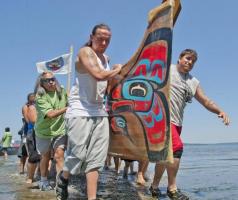 Every year, thousands of people join in on a canoe journey across the Pacific Northwest to celebrate traditional Native American culture. The long paddle includes multiple stops hosted by local tribes along the route. This year’s journey is called Power Paddle to Puyallup. Paddlers in canoes, some traveling as far as British Columbia and California, are expected to arrive in Puyallup, WA, this Friday, July 28. More than 10,000 people are expected for the welcoming ceremony. The Puyallup Tribe will host the event for eight days, July 29-Aug 4, which includes feasting, singing, dancing, drumming and sharing through giveaways. This year’s theme is “Honoring Our Medicine.”
Every year, thousands of people join in on a canoe journey across the Pacific Northwest to celebrate traditional Native American culture. The long paddle includes multiple stops hosted by local tribes along the route. This year’s journey is called Power Paddle to Puyallup. Paddlers in canoes, some traveling as far as British Columbia and California, are expected to arrive in Puyallup, WA, this Friday, July 28. More than 10,000 people are expected for the welcoming ceremony. The Puyallup Tribe will host the event for eight days, July 29-Aug 4, which includes feasting, singing, dancing, drumming and sharing through giveaways. This year’s theme is “Honoring Our Medicine.”
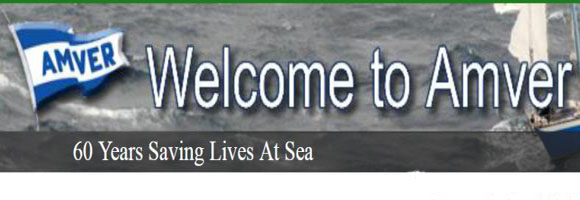 We are a few days late in celebrating AMVER‘s 60th birthday. Originally called the Atlantic Merchant Vessel Emergency Reporting System, AMVER became operational on July 18, 1958. When it expanded beyond the Atlantic, the name was changed to the Automated Mutual Assistance Vessel Rescue System. As we wrote eight years ago, AMVER is the most amazing world-wide maritime search and rescue network that you probably have never heard of. And it has been saving sailors’ lives for over 60 years.
We are a few days late in celebrating AMVER‘s 60th birthday. Originally called the Atlantic Merchant Vessel Emergency Reporting System, AMVER became operational on July 18, 1958. When it expanded beyond the Atlantic, the name was changed to the Automated Mutual Assistance Vessel Rescue System. As we wrote eight years ago, AMVER is the most amazing world-wide maritime search and rescue network that you probably have never heard of. And it has been saving sailors’ lives for over 60 years.
AMVER is a voluntary system sponsored by the US Coast Guard. Vessels registered in the program agree to automatically report their positions. When the Coast Guard receives a distress call from an EPIRB or other means, it sees which ships are the closest to those calling for help and vectors the ship to assist.
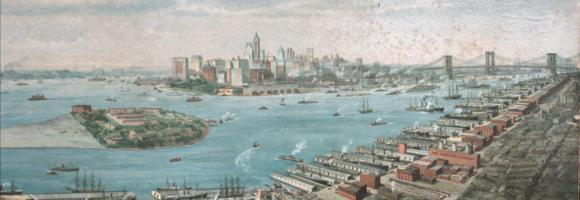
Photo: Chris Kreussling
As part of the continuing Erie Canal Bicentennial celebration, the Waterfront Alliance is sponsoring a harbor tour on August 2. During the tour, I will be providing commentary and narration on the enormous impact that the Erie Canal has had on the harbor and in making New York the remarkable city that it is today.
Departing from Pier 81, at W 41st Street on the Hudson River, we will sail down the Manhattan shore with a brief detour to the mouth of the Morris Canal Basin, part of the 40 years of canal building inspired by the success of the Erie Canal. We will also be passing the Central Railroad of New Jersey Terminal at Liberty State Park, a portion of the rail network that gradually grew more competitive than the canals, but still required barges to cross the Hudson. Then we’ll cross around the Battery, down Buttermilk Channel, and slowly cruise around the Atlantic and Erie Basins.
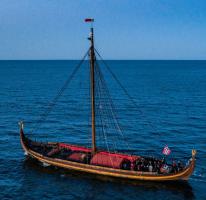
Photo: Smith Aerial Photography
We have been posting about the ongoing East Coast tour by the Viking longship Draken Harald Hårfagre. Here is a lovely drone video by Ryan Smith of the longship as she departs Plymouth, MA bound for Rockland, ME.
The 115 foot long Draken Harald Hårfagre is the largest Viking longship built in modern times. In late April 2016, Draken Harald Hårfagre set out from her home port in Haugesund, Norway on an epic voyage across the Atlantic to America. She visited ports on the US and Canadian East coasts as well as in the Great Lakes before wintering in Mystic Seaport. She was on display at Mystic in the summer of 2017.
Following her port call in Rockland, the longship will sail for Portland, ME. Additional port calls will be announced. Draken Harald Hårfagre will be returning to Mystic Seaport in October.
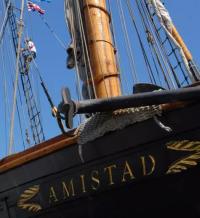 The schooner Amistad is coming to PortSide NewYork, at Pier 11 in the Atlantic Basin, in Red Hook, Brooklyn. Amistad will tie up alongside the historic tanker, Mary A. Whalen, and will be available for free public tours on Tuesday, July 24th and Saturday, August 11th. The visit by the Amistad is part of the African American Maritime Heritage program of PortSide NewYork
The schooner Amistad is coming to PortSide NewYork, at Pier 11 in the Atlantic Basin, in Red Hook, Brooklyn. Amistad will tie up alongside the historic tanker, Mary A. Whalen, and will be available for free public tours on Tuesday, July 24th and Saturday, August 11th. The visit by the Amistad is part of the African American Maritime Heritage program of PortSide NewYork
The Amistad, known as the “Freedom Schooner”, is a replica of the original Baltimore clipper of the same name which, in 1839, was seized by captive Africans from Sierra Leone, who had been sold as slaves. The schooner was ultimately intercepted off New London, CT where the Africans were jailed and charged with murder. Abolitionists from Connecticut and surrounding states supported the captives in their case which was ultimately brought before the U.S. Supreme Court. In 1841, the court agreed with the lower court decisions, ruling that “…it was the ultimate right of all human beings in extreme cases to resist oppression, and to apply force against ruinous injustice.” The captives were freed and returned to their homes.
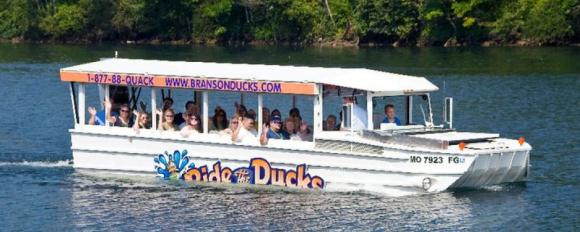 At least 11 people died on Thursday when an amphibious duck boat capsized in Table Rock Lake near Branson, Mo. Six people are still missing. The boat capsized in a thunderstorm in winds reported to be 70 or 80 mph. Of the 31 people on the boat, 29 were passengers and two were crew members. Seven people were taken to a hospital, and two people are reported to be in critical condition at Cox Medical Center Branson. Two duck boats were on the lake when the storm hit. One boat was able to make it to shore.
At least 11 people died on Thursday when an amphibious duck boat capsized in Table Rock Lake near Branson, Mo. Six people are still missing. The boat capsized in a thunderstorm in winds reported to be 70 or 80 mph. Of the 31 people on the boat, 29 were passengers and two were crew members. Seven people were taken to a hospital, and two people are reported to be in critical condition at Cox Medical Center Branson. Two duck boats were on the lake when the storm hit. One boat was able to make it to shore.
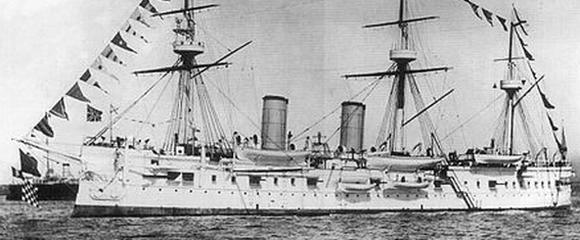 Salvors have announced the discovery of the wreck of the Russian armored cruiser, Dmitrii Donskoi, which was scuttled in 1905 during the Russo-Japanese War following the Battle of Tsushima. The wreck was found in 1,400 feet of water about one mile off the South Korean island of Ulleungdo. The salvors also claimed that the ship may contain 200 tons of gold, which would be worth around $133.4 billion (£102bn) in today’s prices. Allegedly, the Dmitrii Donskoi, which was designed as a commerce raider, was carrying the entire supply of gold for the Russian Second Pacific Squadron.
Salvors have announced the discovery of the wreck of the Russian armored cruiser, Dmitrii Donskoi, which was scuttled in 1905 during the Russo-Japanese War following the Battle of Tsushima. The wreck was found in 1,400 feet of water about one mile off the South Korean island of Ulleungdo. The salvors also claimed that the ship may contain 200 tons of gold, which would be worth around $133.4 billion (£102bn) in today’s prices. Allegedly, the Dmitrii Donskoi, which was designed as a commerce raider, was carrying the entire supply of gold for the Russian Second Pacific Squadron.
There appears to be little doubt that the Seoul-based maritime salvage company Shinil Group has found the wreck of the Dmitrii Donskoi, based on photos and video. A diver in one of the submersibles picked out the name in Cyrillic characters on its stern. But, is there really a vast cache of gold aboard? That is the really interesting question. What evidence is there that the Imperial Russian Navy saw fit to put 200 tonnes of gold aboard a lightly armored commerce raider?
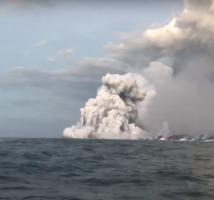 On Monday, the name “Hot Spot“ proved dangerously prophetic for a tour boat operating in waters off the coast of Kapoho on the Big Island of Hawaii. The tour boat was carrying about 49 passengers at around 6 AM, observing the flow of lava into the sea from the Kilauea volcano, when the boat was struck by a lava explosion.
On Monday, the name “Hot Spot“ proved dangerously prophetic for a tour boat operating in waters off the coast of Kapoho on the Big Island of Hawaii. The tour boat was carrying about 49 passengers at around 6 AM, observing the flow of lava into the sea from the Kilauea volcano, when the boat was struck by a lava explosion.
A basketball-sized “lava bomb” hit the roof of the tour boat, injuring at least 23 passengers. One woman who suffered a broken femur was later airlifted to the Queen’s Medical Center on Oahu for emergency treatment. The boat named “Hot Spot” returned to Wailoa Harbor in Hilo with the injured passengers. Four passengers, including the woman who was later airlifted to Oahu, were taken by ambulance to the Hilo Medical Center.
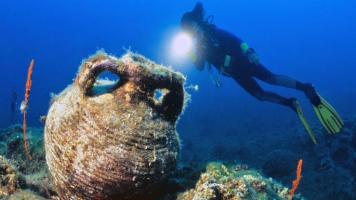 Can Albania both protect and profit from the veritable treasure trove of shipwrecks, ancient and modern, which lie off its coast? Along a 220 stretch of the Ionian coast, there are dozens of wrecks dating from the 6th century B.C. through World War II. The Albania National Coastline Agency thinks that there is the potential to make underwater archeology part of the tourism industry. The immediate concern, however, is whether they have the resources to chart and protect the largely undocumented wrecks before they are stripped by looters. Some looting has already begun. Amphorae from the wrecks are not infrequently seen decorating restaurants along the Albanian coastline.
Can Albania both protect and profit from the veritable treasure trove of shipwrecks, ancient and modern, which lie off its coast? Along a 220 stretch of the Ionian coast, there are dozens of wrecks dating from the 6th century B.C. through World War II. The Albania National Coastline Agency thinks that there is the potential to make underwater archeology part of the tourism industry. The immediate concern, however, is whether they have the resources to chart and protect the largely undocumented wrecks before they are stripped by looters. Some looting has already begun. Amphorae from the wrecks are not infrequently seen decorating restaurants along the Albanian coastline.
This video, another in the “True Facts About” series, seems appropriate for a Monday. Informative, yet likely to generate a chuckle.
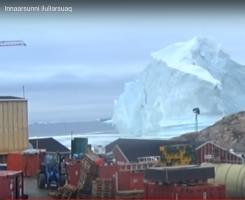 A 300 foot high, 11-million-ton iceberg is threatening the tiny Greenland village of Innaarsuit. The massive iceberg has grounded just off the coast. The concern is that if the iceberg should calve, the plunging ice could create a tsunami-like wave that could inundate the village of 170. Those living closest to shore have been evacuated to higher ground. The village’s power station and fuel tanks, however, are also located close to the shore.
A 300 foot high, 11-million-ton iceberg is threatening the tiny Greenland village of Innaarsuit. The massive iceberg has grounded just off the coast. The concern is that if the iceberg should calve, the plunging ice could create a tsunami-like wave that could inundate the village of 170. Those living closest to shore have been evacuated to higher ground. The village’s power station and fuel tanks, however, are also located close to the shore.
The Guardian quotes William Colgan, a Geological Survey of Denmark and Greenland researcher — “Iceberg production in Greenland has been increasing in the past 100 years as climate change has become stronger,” he said, while the rising number of icebergs were in turn “increasing the tsunami hazards”.
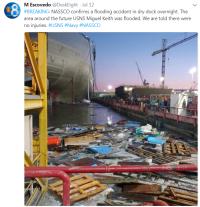 Oops. Last Wednesday, the graving dock at the General Dynamics NASSCO yard in San Diego, CA flooded after the dock gate at least partially collapsed. The ship under construction in the graving dock, the USNS Miguel Keith, floated off the docking blocks while also flooding the ship through cuts in its hull. No one was injured and there is no estimate of damage to the ship which was expected to be delivered in August of 2019.
Oops. Last Wednesday, the graving dock at the General Dynamics NASSCO yard in San Diego, CA flooded after the dock gate at least partially collapsed. The ship under construction in the graving dock, the USNS Miguel Keith, floated off the docking blocks while also flooding the ship through cuts in its hull. No one was injured and there is no estimate of damage to the ship which was expected to be delivered in August of 2019.
A graving dock is a type of drydock built as a narrow basin closed by gates or by a caisson, into which a vessel may be floated and the water pumped out, leaving the vessel supported on blocks. The graving dock at the NASSCO yard is the 1,000-foot long and 174-foot wide.
The USNS Miguel Keith is the third Expeditionary Sea Base built for the US Navy. The two Navy Expeditionary Sea Bases now in service are the USNS Lewis B. Puller (T-ESB 3) and the Hershel “Woody” Williams (ESB 4).
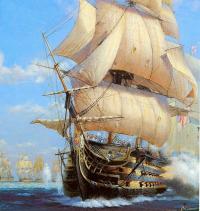 On July 21, the fore topsail set on HMS Victory at the Battle of Trafalgar of 1805 will go on display in all its perforated glory. The sail has 90 shot holes and will be displayed for a limited time over the summer at the Portsmouth Historic Dockyard. The sail’s area is 3,618 feet, equivalent to the size of two tennis courts.
On July 21, the fore topsail set on HMS Victory at the Battle of Trafalgar of 1805 will go on display in all its perforated glory. The sail has 90 shot holes and will be displayed for a limited time over the summer at the Portsmouth Historic Dockyard. The sail’s area is 3,618 feet, equivalent to the size of two tennis courts.
Matthew Sheldon, Director of Heritage at the NMRN, said: ‘HMS Victory, Nelson and the Battle of Trafalgar are key to our history. The sail is an amazing object, scarred by battle and, like HMS Victory herself, a proud survivor of an iconic battle. ‘But it is also a vast handmade object from Georgian times that required great skill and knowledge to create. Seeing it is a real treat.’
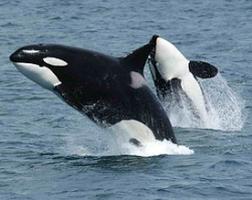 The resident orcas of the Salish Sea are dying. They now number only 75, a 30-year-low. They are being starved as their primary prey, the Chinook, or king salmon, are dying off. They are also being poisoned by pollutants in their waters and hurt by noise pollution from ships and boats. For the last three years, not one calf has been born to the three orca pods in the Salish Sea They have been listed as endangered in both the U.S. and Canada since 2005, but little has been done to reverse their steady decline.
The resident orcas of the Salish Sea are dying. They now number only 75, a 30-year-low. They are being starved as their primary prey, the Chinook, or king salmon, are dying off. They are also being poisoned by pollutants in their waters and hurt by noise pollution from ships and boats. For the last three years, not one calf has been born to the three orca pods in the Salish Sea They have been listed as endangered in both the U.S. and Canada since 2005, but little has been done to reverse their steady decline.
There are three distinct groups of orcas, also known as killer whales, on the coast of the Pacific Northwest. Two groups of orcas referred to as residents, eat almost exclusively fish and return to the same areas immediately along the coast year after year. They are divided into Northern and Southern groups.
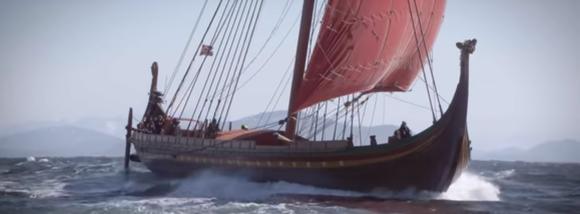 The Draken Harald Hårfagre, the largest Viking longship built in modern times, has begun its summer tour of the East Coast of the United States. After departing from Mystic Seaport on July 9th, it is now bound for Boothbay Harbor, Maine. Only the first three ports of call have been announced as follows:
The Draken Harald Hårfagre, the largest Viking longship built in modern times, has begun its summer tour of the East Coast of the United States. After departing from Mystic Seaport on July 9th, it is now bound for Boothbay Harbor, Maine. Only the first three ports of call have been announced as follows:
- Boothbay Harbor, ME — July 13-15
- Plymouth, MA — July 17-20
- Rockland, ME — July 22-25
An additional eleven port calls will be announced. Draken Harald Hårfagre will be returning to Mystic Seaport in October.
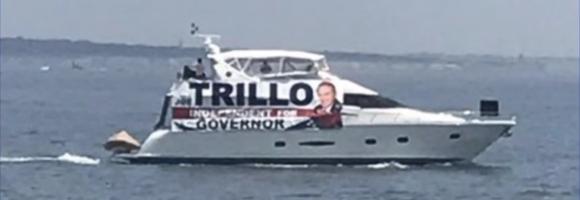 At one point in her long and storied career, the 1885 built, 131-foot schooner yacht Coronet was owned by a rather dodgy religious group which called itself “The Kingdom.” The group was led by Frank Sandford who circumnavigated the globe on the yacht in 1905. What was odd about the voyage was that no one ever went ashore. Instead, Sanford claimed to “subdue the world for Christ” through prayer and by sounding brass instruments as they passed by the various continents. He was not notably successful and on a subsequent voyage, several of his crew died of scurvy. The Coronet, however, has survived and is now being restored by the IYRS School of Technology and Trades in Newport, Rhode Island.
At one point in her long and storied career, the 1885 built, 131-foot schooner yacht Coronet was owned by a rather dodgy religious group which called itself “The Kingdom.” The group was led by Frank Sandford who circumnavigated the globe on the yacht in 1905. What was odd about the voyage was that no one ever went ashore. Instead, Sanford claimed to “subdue the world for Christ” through prayer and by sounding brass instruments as they passed by the various continents. He was not notably successful and on a subsequent voyage, several of his crew died of scurvy. The Coronet, however, has survived and is now being restored by the IYRS School of Technology and Trades in Newport, Rhode Island.
A recent event not too far from Newport reminded me of the story of the Coronet and the sounding of brass offshore. Joe Trillo, an ex-Republican state legislator is running for governor as an independent in Rhode Island this year. His campaign style is almost as unusual as Frank Sandford’s on the Coronet. He is campaigning by yacht and had rather a rocky weekend.
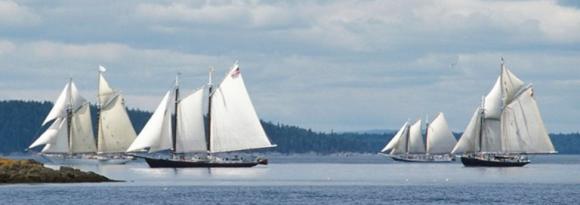
Photo: Maine Windjammer Association
On July 6th, 11 schooners raced from Gilkey Harbor in Islesboro, Maine on Penobscot Bay to the finish line at the Rockland Breakwater Lighthouse in the 42nd Annual Great Schooner Race, sponsored by the Maine Windjammer Association. The race honors, as reported by Village Soup–Knox, went to:
Continue reading
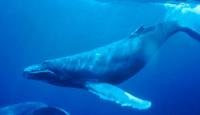 The Trump administration announced that it would cancel a rule designed to protect whales and turtles, which was first implemented in 2016, at the request of the fishing industry. The rule helped limit the number of endangered whales and turtles ensnared in fishing nets and had been recommended by the 14-member Pacific Fishery Management Council, which manages fisheries in California, Oregon, and Washington, in 2015. The rule applies only to the 20 gill-net fishing vessels still operating on the West Coast. The measure protected endangered fin, humpback, and sperm whales; short-finned pilot whales and common bottlenose dolphins; as well as endangered leatherback sea turtles, loggerhead sea turtles, olive ridley sea turtles and green sea turtles. The Trump administration has declared that the protection is unnecessary.
The Trump administration announced that it would cancel a rule designed to protect whales and turtles, which was first implemented in 2016, at the request of the fishing industry. The rule helped limit the number of endangered whales and turtles ensnared in fishing nets and had been recommended by the 14-member Pacific Fishery Management Council, which manages fisheries in California, Oregon, and Washington, in 2015. The rule applies only to the 20 gill-net fishing vessels still operating on the West Coast. The measure protected endangered fin, humpback, and sperm whales; short-finned pilot whales and common bottlenose dolphins; as well as endangered leatherback sea turtles, loggerhead sea turtles, olive ridley sea turtles and green sea turtles. The Trump administration has declared that the protection is unnecessary.
